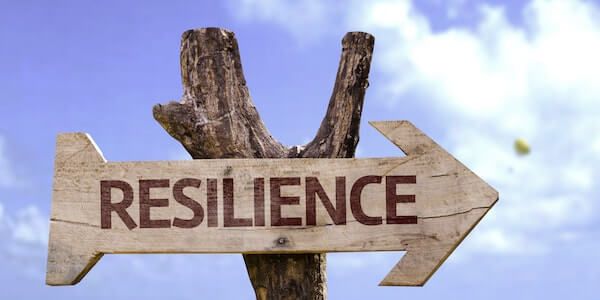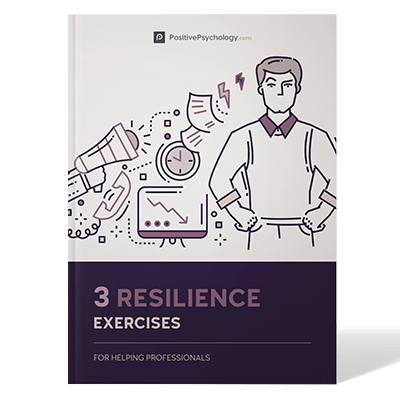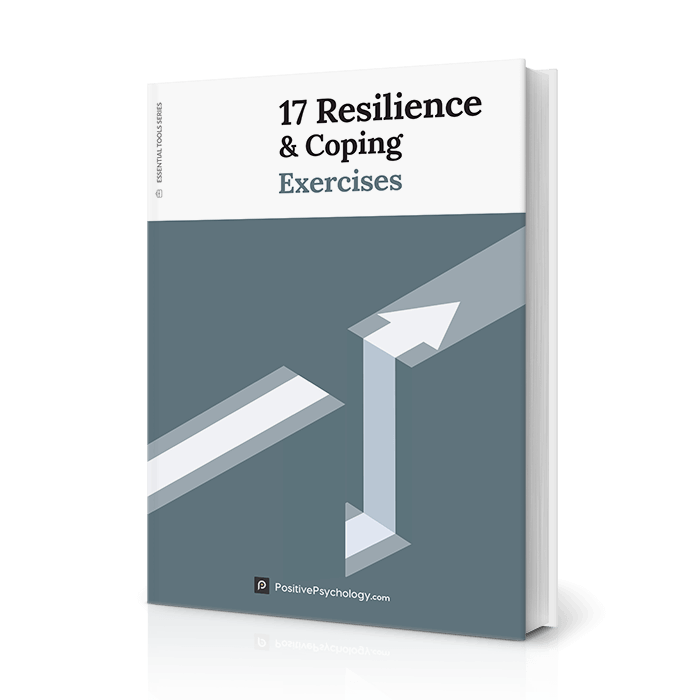How to Measure Resilience With These 8 Scales (+PDF)
 When we experience disaster, trauma, or distressing psychological issues, we usually react with grief and a range of negative emotions.
When we experience disaster, trauma, or distressing psychological issues, we usually react with grief and a range of negative emotions.
This is, of course, a natural reaction to having our hopes dashed or our goals thwarted. However, such experiences are not only an inevitable part of life but virtually required for growth and development.
Persistence and resilience only come from having been given the chance to work through difficult problems.
Gever Tulley
These are the exact sort of experiences that build resilience. With resilience, you can work through the effects of stress and negative emotions and not only bounce back, but actually thrive.
The U.S. Department of Health and Human Services (2015) defines individual resilience as the ability to withstand, adapt to, and recover from adversity and stress. In other words, resilience can manifest as maintaining or returning to one’s original state of mental health or wellbeing or reaching a more mature and well-developed state of mental health or wellbeing through the use of effective coping strategies.
In order to grasp and effectively develop resilience, it is critical to understand the factors contributing to resilience.
Before you read on, we thought you might like to download our three Resilience Exercises for free. These engaging, science-based exercises will help you to effectively deal with difficult circumstances and give you the tools to improve the resilience of your clients, students or employees..
This Article Contains:
Components of Resilience
Resilience is defined differently depending on who you ask; psychological researchers may have one working definition (or many!), while those who work directly with people who are struggling often see it differently.
There is no single accepted set of components of resilience, but this set of characteristics and contributing factors can provide a useful guide:
- Optimism – those who are optimistic tend to be more resilient as well since they are more likely to stay positive about the future even when faced with seemingly insurmountable obstacles.
- Altruism – the most resilient among us often turn to help others when they need to relieve stress and boost their self-efficacy.
- Moral Compass – people with a strong moral compass or steadfast set of beliefs about right and wrong generally have an easier time bouncing back.
- Faith and Spirituality – while not a required factor for resilience, people often find their faith helpful in surviving challenges and coming through stronger and wiser on the other side.
- Humor – people who have a healthy sense of humor and are able to laugh at their own misfortune are at an advantage when it comes to bouncing back, for obvious reasons!
- Having a Role Model – this is also not a requirement for resilience, but those who have a role model in mind can draw strength from their desire to emulate this person.
- Social Supports – unsurprisingly, social support is important when it comes to resilience; those with strong social support networks are better equipped to bounce back from loss or disappointment.
- Facing Fear – this is not so much a characteristic as an action or tendency to act, but people who are willing to leave their comfort zone and confront their fears are more likely to overcome their challenges and grow as a person.
- Meaning or Purpose in Life – it shouldn’t be surprising that those who feel they have a specific purpose in life or find a tremendous amount of meaning in their lives are more likely to recover from failure or disappointment; when you fervently believe you have a purpose, you are less likely to give up when faced with tragedy or loss.
- Training – while a portion of individual resilience may be somewhat permanent and unchangeable, there is an opportunity for improvement; it is possible to improve your resilience through training (Staroverky, 2012).
These components are not present in each and every measure of resilience, but they form a good basis for understanding the nature and scope of resilience. It should be easy to spot most of them in at least one of the eight resilience scales described below.
Seeing the many individual cogs that make up the resilience machine, it is easy to imagine that there are many different ways to define and measure resilience. Indeed, there are virtually countless ways that resilience has been described, and many different methods of measuring it.
The resilience scales below are all useful tools in providing a measure of resilience, but you will see that they are built on different theories, based on different components, and/or created for different populations. Depending on the context in which it will be applied, one resilience scale may be more appropriate than others.
8 Resilience Scales

While there are dozens of resilience measures out there for you to explore, we narrowed them down to the eight most popular and most empirically based resilience scales. These scales are listed and described below.
1) Connor-Davidson Resilience Scale (CD-RISC)
A study conducted by Windle, Bennett, & Noyes (2011) reviewed nineteen resilience measures. However, out of nineteen, only three of them received superior psychometric ratings, one of which is the Connor-Davidson Resilience Scale (CD-RISC).
This scale was originally developed by Connor-Davidson (2003) as a self-report measure of resilience within the Post Traumatic Stress Disorder (PTSD) clinical community (CD-RISC, n.d.). It is a validated and widely recognized scale with 2, 10, and 25 items which measure resilience as a function of five interrelated components:
- Personal Competence
- Acceptance of Change and Secure Relationships
- Trust/Tolerance/Strengthening Effects of Stress
- Control
- Spiritual Influences
With an extensive number of studies using this tool, conducted within a varied range of populations, the CD-RISC is considered one of the higher scoring scales in the psychometric evaluation of resilience (Windle, Bennett, & Noyes, 2011).
2) Resilience Scale for Adults (RSA)
The RSA, another resilience scale rated highly by Windle, Bennett, & Noyes (2011), was authored by Friborg et al. (2003) as a self-report scale targeting adults. It is recommended for use in the health and clinical psychology population.
This scale has five scoring items that examine both the intrapersonal and interpersonal protective factors that promote adaptation to adversity.
The authors, Friborg et al. (2003), noted the key factors which contribute to highly resilient individuals, namely family support and cohesion, external support systems, and dispositional attitudes and behaviors, which the scale items are founded on. They are:
- Personal Competence
- Social Competence
- Social Support
- Family Coherence
- Personal Structure
A later study performed by Friborg et al. (2005) used the RSA to measure the relationship between personality, intelligence, and resilience. They found many links between personality and resilience factors, such as the connection between higher personal competence and elevated emotional stability. There were, however, no significant findings related to cognitive ability (Friborg et al., 2005).
This is in line with Windle et al. (2011), who concluded that the RSA is highly useful for assessing the protective factors which inhibit or provide a buffer against psychological disorders.
3) Brief Resilience Scale
While most resilience assessments look into the factors which develop resilience, The Brief Resilience Scale (BRS) is a self-rating questionnaire aimed at measuring an individuals’ ability to “bounce back from stress”. This instrument, developed by Smith et al. (2008), has not been used in the clinical population; however, it could provide some key insights for individuals with health-related stress (Smith, et al., 2008).
Amat et al. (2014) explain that the BRS instrument consists of six items, three positively worded items, and three negatively worded items. All six relate to the individual’s ability to bounce back from adversity. The scale’s development controlled for protective factors such as social support in order to get a reliable resilience measure (Smith, et al., 2008).
This is the third and final resilience measure noted by Windle et al. (2011) as a highly valid and reliable measure of resilience, but there are many more with evidence to back their effectiveness.
4) Resilience Scale
This scale is the oldest scale on our list but is still in use by many researchers. The Resilience Scale, developed by Wagnild and Young in 1993, was created and validated with a sample of older adults (aged 53 to 95 years). This scale consists of 25 items and the results have been found to positively correlate with physical health, morale, and life satisfaction, while negatively correlating with depression.
The scale is intended to measure resilience based on five essential characteristics:
- Meaningful Life (or Purpose)
- Perseverance
- Self-Reliance
- Equanimity
- Existential Aloneness
These five characteristics are assessed using two subscales, the 17-item Personal Competence subscale and the 8-item Acceptance of Self and Life subscale.
Subsequent validation of the scale in 2009 by Wagnild reaffirmed its internal consistency and construct validity, supporting its continued effectiveness as a tool for the assessment of resilience.
In addition to the original 25-item scale, there is a shortened 14-item scale that has also proven to be valid and reliable in measuring resilience (Abiola & Udofia, 2011).
5) Scale of Protective Factors (SPF)
The Scale of Protective Factors (SPF) was developed by Ponce-Garcia, Madwell, and Kennison in 2015 to capture a comprehensive measurement of resilience. The authors tested and validated this resilience scale in a sample of nearly 1,000 college students, and found the SPF to be a valid and reliable measure of resilience for measuring resilience, especially in groups identified as survivors of violent trauma.
This scale measures resilience in a slightly different way than the previously mentioned scales. It focuses on the factors that combine to create a buffer between individuals who have experienced trauma and the stress and disruption to functioning that can follow, rather the components that constitute resilience directly.
It consists of 24 items measuring two social-interpersonal factors ( and ) and two cognitive-individual factors ( and ).
The SPF has since been validated in a review of resilience scales by Madewell and Ponce-Garcia (2016), providing evidence of its validity and effectiveness in clinical use.
6) Predictive 6-Factor Resilience Scale
The Predictive 6-Factor Resilience Scale was developed based on the neurobiological underpinnings of resilience and the theorized relationship with health hygiene factors (Roussouw & Roussouw, 2016).
The PR6 measures resilience as a function of six domains concerning several interrelated concepts:
- Vision: self-efficacy and goal-setting
- Composure: emotional regulation and the ability to identify, understand, and act on internal prompts and physical signals
- Tenacity: perseverance and hardiness
- Reasoning: higher cognitive traits, like problem-solving, resourcefulness, and thriving
- Collaboration: psychosocial interaction, such as secure attachment, support networks, context, and humor
- Health: physiological health
The PR6 was found to have good internal consistency and correlate with other measures of resilience as well as health hygiene scores.
Based on these results, the PR6 can be considered an effective measurement and a particularly good assessment for use in improving resilience.
7) Ego Resilience Scale
This scale was developed by Block and Kremen in 1996 for use in measuring resilience in non-psychiatric contexts. While the authors term their construct “ego resiliency,” it is basically resilience as we know it viewed in terms of adaptability to changes in one’s circumstances.
The Resilience Scale (RS-14) consists of 14 items rated on a scale from 1 = does not apply to 4 = applies very strongly, with higher scores indicating higher levels of resilience.
Scores on this scale have been found to positively correlate with intelligence as it relates to the ability to adapt, supporting the scale’s ability to assess an individual’s ability to bounce back from failure and disappointment.
8) Academic Resilience Scale (ARS-30)
Finally, the Academic Resilience Scale (ARS-30) is a recently developed measure used to assess resilience in a particular context: academic success. Simon Cassidy (2016) describes academic resilience as the tendency to persevere and succeed in education despite meeting with adversity. It is a multi-dimensional construct focusing on both cognitive affective and behavioral responses to academic adversity.
The ARS-30 is based on responses to a vignette describing a significant academic challenge, rated on a scale from 1 = likely to 5 = unlikely.
The items in this scale fall into one of three factors:
- Perseverance
- Reflecting and Adaptive Help-Seeking
- Negative Affect and Emotional Response
High scores on factors 1 and 2 and low scores on factor 3 indicate high resilience.
This scale was found to be highly internally reliable, and scores correlated significantly with a measure of academic self-efficacy. While the ARS-30 is most appropriate in academic contexts, scores can be useful in other situations as well.
Resilience at Work (and Why It Matters)
“As a leader, apologize for making mistakes. Don’t apologize for making decisions.”
Resilience is an important characteristic in the context of work. Nobody is a consistently perfect employee, and everybody will at some point receive critical feedback or experience a failure at work.
This fact of life highlights the role of resilience in the workplace, as a means for employees to recognize where they have failed or come up short, identify the most constructive ways to move forward, and bounce back with vigor and enthusiasm to get it right the next time.
In addition to the stereotypical experiences that require resilience to survive, resilience is integral in other, less obvious situations as well – we often need to be resilient even in the face of positive changes! Increased responsibility, forward progress, and significant positive events can all result in the need for adaptation and recovery (Youssef & Luthans, 2007).
However, it is usually the responses to negative change that highlight the need for resilience.
In the workplace, a lack of resilience can manifest itself in many ways – the fear of presenting in front of an audience, the frustration after receiving criticism for one’s work, the guilt about not spending enough time with one’s family, the embarrassment one feels after a meeting that didn’t go well.
In the book The Resilience Factor, Karen Reivich and Andrew Shatté (2002) identify the five typical emotions that are associated with a lack of resilience, namely;
- Anger
- Sadness or Depression
- Guilt
- Anxiety or Fear
- Embarrassment
Of course, these emotions are completely natural to experience from time to time. The key to recognizing these emotions as indicators of a lack of resilience is whether they are disproportionate to the event (looking back you might catch yourself thinking “that was over the top!”), or if the same event triggers the same emotion repeatedly.
For those who identify with this description, an increase in resilience would be hugely beneficial.
In the workplace, a lack of resilience can become an issue when it prevents you from developing your skills and interacting effectively with others. For example, a fear of public speaking may lead you to remain silent even when you know you have something to contribute to a discussion. Another example is if you become defensive when receiving negative feedback, losing the opportunity to learn and develop your skills.
In short, a lack of resilience can have an immediate impact on motivation, cognitive functioning, and emotional wellbeing. In cases of a serious lack of resilience, it leads to helplessness and seeing oneself as a victim of circumstance.
Conversely, we all know people who immediately pick themselves up and dust themselves off after a setback, regardless of what stressors and tragedies life throws at them. In general, resilience is defined as the ability to bounce back from adversity, and resilient people practice resilience by assessing and exploring all of their options before taking action. These tendencies make it unlikely that they repeat unhelpful past experiences.
For us to flourish and thrive at work (and at home, for that matter) we need to ensure we recognize those emotions as they arise, assess whether they are appropriate, take responsibility for our lack of resilience, if that is the case, and apply the tools to reframe our experiences.
11 Reasons Why Organizations Should Pay Attention to Resilience

Four of the most important reasons why organizations should understand the contributors of resilience and start introducing programs which build resilience are:
General Employee Wellbeing
While organizations can work to address workload issues in parallel, resilience skills directly benefit employees’ psychological wellbeing by helping them reframe their perception of stress. Healthy and happy employees are productive employees, making employee wellbeing an important consideration for every organization.
Career Development
Employees looking to grow and develop their skills will benefit from learning to cope with adverse work situations, such as negative feedback. Managers who understand the dynamics of resilience can coach their employees much more effectively.
Research has shown that people (and women in particular) who tend to attribute their failures to personal shortcomings are at risk of diminishing self-confidence, a problem that can be addressed through the development of resilience skills.
Innovation & The Learning Curve
Most companies need to innovate on an ongoing basis to survive in this business climate. This means that employees need to work constantly on maintaining and upgrading their capabilities. This can be hampered by the so-called learning curve – essentially the experience of a dip in skill and motivation as individuals learn to apply a new skill. This can be frustrating and possibly lead to stagnation if the new skills are not applied successfully.
Managers who recognize that their employees are displaying signs of “non-resilience” during this learning curve (rather than interpreting the same behavior as non-cooperation, for example) can jump right in and begin providing the appropriate support, thus ensuring effective learning and laying the groundwork for successful innovation.
Teamwork
A lack of resilience often becomes apparent in our interpersonal situations. By understanding typical behaviors linked to a lack of resilience, leaders can encourage employees to examine their thinking patterns and change their interpretation of the situation, thereby reducing negative feelings between team members and improving team dynamics.
In short, resilient employees are simply better employees, on average. They meet their challenges in different ways, develop and maintain better buffers against stress and anxiety, and more effectively recover from the setbacks that everyone experiences from time to time.
Paula Davis-Laack (2014), a positive psychologist who has applied her knowledge and skills to the practice enhancing resilience in thousands of working professionals, lays out the seven ways that resilient employees do things differently, benefitting both themselves and their organization.
Highly resilient employees:
- Develop high-quality connections
- Manage stress effectively and avoid burnout
- Act authentically and in accordance with their strengths and values
- Develop grit (the passion and perseverance to pursue long-term goals)
- Stay inspired and find meaning
- Stay flexible and mentally tough
- Actively manage change and setbacks
Any leader would agree that these seven capabilities are extremely desirable in employees. These are the employees that produce high-quality work, innovate, and spread their inspiration and motivation to their colleagues.
Luckily for leaders everywhere, resilience is a characteristic that can be built, developed, and enhanced in any workforce (Youssef & Luthans, 2007).
Building Resilience at Work and Beyond

“The ability to take misfortune and make something good come of it is a rare gift. Those who possess it (…) are said to have resilience or courage.”
While some people certainly seem to be born with the resilience gene, some of the necessary skills of resilience can also be learned when practiced over time.
There are a number of useful models and tools that offer frames for understanding and building resilience. The following three models address the topic of resilience from various angles and can provide useful insights.
1. The ABCDE model
Briefly described by Seligman (2012) and addressed in detail in Reivich and Shatté (2002), this model explains how the five key negative emotions mentioned earlier in this article are linked to specific experiences. Feeling angry is usually linked to the perceived violation of one’s rights. Feeling embarrassed is usually the result of an unfavorable social comparison. Sadness and depression are often linked to the loss of self-worth.
These 5 specific steps introduced in this ABCDE model offer the keys to building resilience:
- Adversity (recognizing any unfavorable thought patterns)
- Beliefs (finding the true reason behind the emotions)
- Consequences (recognizing the negative impact of these emotions)
- Disputation (learning to challenge them)
- Energization (begin choosing new and more effective courses of action)
2. The 7 Pillars of Resilience
This model by German psychotherapist Micheline Rampe (2010) is useful for understanding the key steps that need to be taken by an individual on their journey to resilience. Many of the strategies described by Rampe (2010) are compatible with approaches recommended in positive psychology literature.
These 7 pillars are:
- Developing optimism (leading to positive expectations enabling a person to take positive action)
- Acceptance of the situation
- Focusing on potential solutions
- Taking responsibility for one’s own life
- Escaping from the role as a victim of circumstance
- Building a support network
- Planning a flexible strategy for dealing with future challenges
These pillars offer key steps that give an individual the tools for dealing with adversity in a positive and constructive way.
It should be noted that in the absence of real, objective reasons that things are going to be better, hope and optimism can be counter-productive. Without subsequent improvement in circumstances, there is a good chance that unrealistic hope and optimism will lead to disappointment.
If nothing changes about your situation or your course of action, how can you expect things to be different in the future? This is called “big optimism” and or false hope, and it should not be encouraged in those who are not naturally highly optimistic.
3. The Three Musketeers of Resilience
The book Restore Yourself by Edy Greenblatt (2009) presents strategies for combating professional exhaustion and burnout by focusing on regular restoration of personal resources.
The “three musketeers” described by Greenblatt are;
- Gaining an understanding of what restores or depletes a person’s energy (what may be perceived as stress by one person may be seen as relaxing for another, such as violent video games)
- Questioning social tags such as “work” or “vacation” to identify their true restoration and depletion triggers (essentially getting more specific about situations that give or deplete energy both at work and in our private life)
- Becoming aware that, over time, a person’s sources of depletion and restoration will change and adapt accordingly
These models can be employed by individuals hoping to develop their own resilience as well as by organizations interested in building a resilient workforce. While true resilience requires one to take responsibility for their own life, there are ways to encourage the development of resilience in employees.
For example, George Everly, Jr. (2011) describes how organizations can build a resilient organizational culture in an article from the Harvard Business Review.
The framework Everly, Jr. outlines is a simple one:
- People prosper from success – creating an environment in which employees have the tools to succeed will help build resilient employees.
- People learn while observing others – encourage formal and informal professional groups within the organization and place new employees in successful working groups to encourage them to model that success.
- Encouragement, support, and mentoring are vital – interpersonal support is one of the strongest predictors of success and resilience.
- Managing stress is key – providing employees with basic training in managing their stress can pay huge dividends in increased productivity and enhanced quality, not to mention fewer absences and healthier employees.
Consistent with this framework, Everly, Jr. notes two impactful things organizations have done to infuse their workforce with resilience, including:
- Investing in their leaders by providing training in resilience and resilient leadership skills.
- Investing in all levels of the workforce by promoting employee health and wellness, in the form of employee wellness programs, workshops on physical fitness and nutrition, and stress management training for employees and their families.
Forbes contributor Alan Kohll (2017) echoes these lessons in building a resilient workforce, noting that the development of resilience can be enhanced by organizations through:
- Leading by example and building resilience at the executive level and in the management team
- Fostering a sense of purpose and helping employees find meaning in their work
- Promoting a sense of control and self-confidence in employees
- Managing change effectively and responsibly to ensure that change is seen as an opportunity rather than a roadblock
- Encouraging employee connections, whether formal or informal, through mentorship and company-recognized employee interest groups
- Addressing stress levels, both in the organization as a whole and in individual employees
- Nurturing a healthy sense of humor in the workplace (the appropriate level will depend on the organization and the industry)
- Fostering grit and mental toughness in employees
- Providing as many opportunities as possible for learning and professional development
- Staying optimistic and using positive messaging
- Encouraging flexibility and adaptability in employees, workgroups, and the organization as a whole
- Building problem-solving skills at all levels of the company
- Promoting good habits for physical and mental health
Of course, there are also ways in which individuals can work on building their resilience in both their personal lives and the workplace as well. Rich Fernandez, veteran director of learning and organizational development at companies like Google, eBay, and J. P. Morgan Chase, provides five suggestions for enhancing your resilience at work (2016):
- Exercise mindfulness to manage and minimize stress,
- Compartmentalize your work to enhance your productivity and decrease cognitive strain,
- Take “detachment breaks” to work with your natural mental focus, clarity, and energy cycles,
- Developmental agility to respond thoughtfully and constructively to stress,
- Cultivate compassion for yourself and for others to enhance your wellbeing and decrease stress.
If building a resilient workforce is your goal for the future, investing in our course ‘Realizing Resilience Masterclass‘, would give you the exact tools you need for this admirable goal. Not only can the course be done online, but all the material will be available to your organization due to the Extended Usage Rights.
Want to Learn More About Resilience?
Download the ‘Road to Resilience’ PDF by the Discovery Health Channel and American Psychological Association or watch Sam Goldstein’s excellent TED Talk on the Power of Resilience.
A Take-Home Message
Resilience is the incredibly useful ability to adapt and cope with adversities and stresses, and fortunately for us, it can be built and developed over time. The eight resilience scales presented here can be utilized to get a general idea of how resilient you (or your employees) are, and hopefully, the tips on building resilience can help you go from there.
It is important to note that most resilience measures have been developed, researched and put to use in the West and when the resilience scales are applied to non-Western populations, validity and reliability issues may arise. It is the duty of each researcher to consider the internal consistency and validity of their selected resilience scale in the context of their population (Amat et al. 2014).
If more organizations devote their attention to the resilience of their workforce and focus on building resilience at every level, they will be better able to prevent and combat stress and burnout and build a thriving organization full of capable, productive, and flourishing individuals.
I wish you the best of luck as you use this information to measure, share, and build resilience in your communities.
Thank you for reading, and please reach out to us in the comments if you have any thoughts about the resilience scales mentioned or measuring resilience in general. We’d love to hear from you!
We hope you enjoyed reading this article. Don’t forget to download our three Resilience Exercises for free.
- Abiola, T., & Udofia, O. (2011). Psychometric assessment of the Wagnild and Young’s resilience scale in Kano, Nigeria. BMC Research Notes, 4(1), 1-5.
- Amat, S., Subhan, M., Jaafar, W. M. W., Mahmud, Z., & Johari, K. S. K. (2014). Evaluation and psychometric status of the brief resilience scale in a sample of Malaysian international students. Asian Social Science, 10, 240-245.
- Cassidy, S. (2016). The Academic Resilience Scale (ARS-30): A new multidimensional construct measure. Frontiers in Psychology, 7, 1787.
- Csikszentmihalyi, M. (2002) Flow: The psychology of happiness. London, UK: Random House.
- Davis-Laack, P. (2014, October 2). Seven things resilient employees do differently. Psychology Today. Retrieved from https://www.psychologytoday.com/blog/pressure-proof/201410/seven-things-resilient-employees-do-differently
- Everly, Jr., G. S. (2011, June 24). Building a resilient organizational culture. Harvard Business Review. Retrieved from https://hbr.org/2011/06/building-a-resilient-organizat
- Fernandez, R. (2016, June 27). 5 ways to boost your resilience at work. Harvard Business Review. Retrieved from https://hbr.org/2016/06/627-building-resilience-ic-5-ways-to-build-your-personal-resilience-at-work
- Friborg, O., Hjemdal, O., Rosenvinge, J. H., & Martinussen, M. (2003). A new rating scale for adult resilience: What are the central protective resources behind healthy adjustment? International Journal of Methods in Psychiatric Research, 12(2), 65-76.
- Greenblatt, E. (2009). Restore yourself: The antidote for professional exhaustion. Los Angeles, CA: Execu-Care Press.
- Kohll, A. (2017, January 5). How you can build a more resilient workforce. Forbes. Retrieved from https://www.forbes.com/sites/alankohll/2017/01/05/how-you-can-build-a-more-resilient-workforce/2/#d707edc3f031
- Madewell, A. N., & Ponce-Garcia, E. (2016). Assessing resilience in emerging adulthood: The Resilience Scale (RS), Connor–Davidson Resilience Scale (CD-RISC), and Scale of Protective Factors (SPF). Personality and Individual Differences, 97, 249-255.
- Ponce-Garcia, E., Madewell, A. N., & Kennison, S. M. (2015). The development of the scale of protective factors: Resilience in a violent trauma sample. Violence and Victims, 30(5), 735-755.
- Rampe, M. (2010). Der R-Faktor. Hamburg & Norderstedt: Books on Demand
- Reivich, K., & Shatté, A. (2002) The resilience factor: 7 essential skills for overcoming life’s inevitable obstacles. New York, NY: Three Rivers Press.
- Rossouw, P. J., & Rossouw, J. G. (2016). The predictive 6-factor resilience scale: Neurobiological fundamentals and organizational application. International Journal of Neuropsychotherapy, 4(1), 31-45.
- Seligman, M. (2012). Flourish: A visionary new understanding of happiness and well-being. New York, NY: Free Press.
- Smith, B. W., Dalen, J., Wiggins, K., Tooley, E., Christopher, P., & Bernard, J. (2008). The brief resilience scale: Assessing the ability to bounce back. International Journal of Behavioral Medicine, 15(3), 194-200.
- Staroversky, I. (2012, October 1). What is resilience? 10 critical characteristics of resilience. StarOverSky Counseling & Psychotherapy. Retrieved from https://staroversky.com/blog/what-is-resilience-10-critical-characteristics-of-resilience
- The Connor-Davidson Resilience Scale (n.d.). In CD-RISC User Guide. Retrieved from http://www.cd-risc.com/user-guide.php
- U.S. Department of Health and Human Services. (2015). Individual resilience. Public Health and Medical Emergency Support for a National Prepared. Retrieved from http://www.phe.gov/Preparedness/planning/abc/Pages/individual-resilience.aspx
- Wagnild, G. (2009). A review of the Resilience Scale. Journal of Nursing Measurement, 17(2), 105-113.
- Wagnild, G. M., & Young, H. M. (1993). Development and psychometric. Journal of Nursing Measurement, 1(2), 165-178.
- Windle, G., Bennett, K. M., & Noyes, J. (2011). A methodological review of resilience measurement scales. Health and Quality of Life Outcomes, 9(1), 1-18.
- Youssef, C. M., & Luthans, F. (2007). Positive organizational behavior in the workplace: The impact of hope, optimism, and resilience. Journal of Management, 33(5), 774-800.
Let us know your thoughts
Read other articles by their category
- Body & Brain (49)
- Coaching & Application (57)
- Compassion (26)
- Counseling (51)
- Emotional Intelligence (24)
- Gratitude (18)
- Grief & Bereavement (21)
- Happiness & SWB (40)
- Meaning & Values (26)
- Meditation (20)
- Mindfulness (45)
- Motivation & Goals (45)
- Optimism & Mindset (34)
- Positive CBT (28)
- Positive Communication (20)
- Positive Education (47)
- Positive Emotions (32)
- Positive Leadership (18)
- Positive Parenting (4)
- Positive Psychology (33)
- Positive Workplace (37)
- Productivity (16)
- Relationships (46)
- Resilience & Coping (36)
- Self Awareness (21)
- Self Esteem (38)
- Strengths & Virtues (31)
- Stress & Burnout Prevention (34)
- Theory & Books (46)
- Therapy Exercises (37)
- Types of Therapy (64)






What our readers think
Hello we are doing resilience-building lectures in our program which will be part of our study can I use the information in the article.
Regards
Hello Dr. Kashyap,
Yes, feel free to use this content for your research. You’ll see that many conclusions are drawn from cited sources beyond this website, so just ensure you are referencing these in your paper (you’ll find the sources in the reference list at the end of the post).
Good luck with your research!
Kind regards,
Julia | Community Manager
Hi good day! I am conducting research in regards to the emotional resilience of an adolescent. Can I ask permission if I can use the Brief resilience scale . Any suggestions is highly appreciated. Thank you very much.
Hi Ela,
This scale is freely available to use and a copy of it with scoring information can be accessed here.
Hope this helps!
Kind regards,
Julia | Community Manager
HELLO!
I WOULD YOU LIKE FIND FOLLOWING TEST THE AUTORS WAGNILD AND YOUNG.
TITLE: The Resilience Scale User’s Guide
You can help me please. Thank you.
Hi Eleicer,
You can download the original paper with the scale items and further details here: https://cyberleninka.org/article/n/255719.pdf
Hope this helps!
– Nicole | Community Manager
Hello – I am having difficulty finding an appropriae scale to measure organizational resilience. Many of the scales I have found are personal, not organizational. Any direction is welcomed. Thank you!
Hi April,
It’s good that you’re taking level of analysis into consideration! I’d suggest taking a look at the scale by Chen et al. (2021): https://doi.org/10.3390/su13052517
Another alternative may be Kantur & Say (2015): https://dergipark.org.tr/en/pub/jbef/issue/32406/360419
Hope this helps!
– Nicole | Community Manager